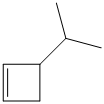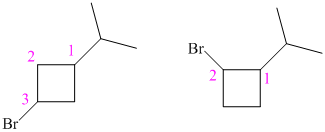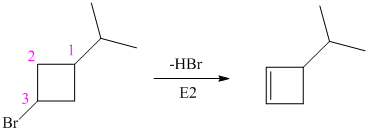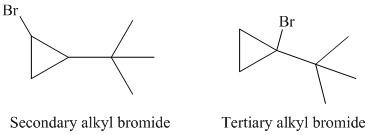
Interpretation:
The compound with the molecular formula
Concept introduction:
>The
In dehydrohalogenation
The elimination of primary alkyl halides proceeds through
In
According to Zaitsev rule, the most substituted alkene is the major product.
Answer to Problem 43P
Solution:
The compounds of molecular formula
a)

b)

c)

d)

e)

f)

Explanation of Solution
a) The structure of the given alkene as the product of

In
Hence, the structure of alkyl bromide is as follows:

b) The structure of the given alkene as the product of

In
So, there are two possible structures of alkyl bromide which are as follows:

The primary alkyl bromide forms the desired product but the tertiary alkyl bromide can form two alkenes with trisubstituted alkene as the major product. The reaction is as follows:


Hence, the structure of the compound that forms the given alkene as an exclusive product of

c)The structure of given alkene as the product of

In
So, there are two possible structures of alkyl bromide as follows:

The alkyl bromide in which


Hence, the structure of the compound that forms the given alkene as an exclusive product of

d) The structure of the given alkene as the product of

In
So, there are two possible structures of alkyl bromide as follows:

The primary alkyl bromide forms the desired product but the secondary alkyl bromide can form two alkenes with trisubstituted alkene as the major product.


Hence, the structure of the compound that forms the given alkene as an exclusive product of

e) The structural formula of the given alkene is shown below:

In
So, there are two possible structures of alkyl bromide as follows:

The alkyl bromide in which


Hence, the structure of the compound that forms the given alkene as an exclusive product of

f) The structural formula of the given alkene is shown below:

In
So, there are two possible structures of alkyl bromide as follows:

The secondary alkyl bromide forms two alkenesbut the tertiary alkyl bromide forms only the desired product as shown in following equations:


Hence, the structure of the compound that forms the given alkene as an exclusive product of

Want to see more full solutions like this?
Chapter 7 Solutions
ORGANIC CHEMISTRY-PACKAGE >CUSTOM<
- Synthesize 2-Ethyl-3-methyloxirane from dimethyl(propyl)sulfonium iodide using the necessary organic or inorganic reagents. Draw the structures of the compounds.arrow_forwardSynthesize 2-Hydroxy-2-phenylacetonitrile from phenylmethanol using the necessary organic or inorganic reagents. Draw the structures of the compounds.arrow_forwardSynthesize N-Methylcyclohexylamine from cyclohexanol using the necessary organic or inorganic reagents. Draw the structures of the compounds.arrow_forward
- Synthesize N-Methylcyclohexylamine from cyclohexanol using the necessary organic or inorganic reagents. Draw the structures of the compounds.arrow_forwardIf possible, please provide the formula of the compound 3,3-dimethylbut-2-enal.arrow_forwardSynthesize 1,4-dibromobenzene from acetanilide (N-phenylacetamide) using the necessary organic or inorganic reagents. Draw the structures of the compounds.arrow_forward
- Indicate the products obtained by mixing (3-oxo-3-phenylpropyl)triphenylphosphonium bromide with sodium hydride.arrow_forwardWe mix N-ethyl-2-hexanamine with excess methyl iodide and followed by heating with aqueous Ag2O. Indicate the major products obtained.arrow_forwardIndicate the products obtained by mixing acetophenone with iodine and NaOH.arrow_forward
- Indicate the products obtained by mixing 2-Propanone and ethyllithium and performing a subsequent acid hydrolysis.arrow_forwardIndicate the products obtained if (E)-2-butenal and 3-oxo-butanenitrile are mixed with sodium ethoxide in ethanol.arrow_forwardQuestion 3 (4 points), Draw a full arrow-pushing mechanism for the following reaction Please draw all structures clearly. Note that this intramolecular cyclization is analogous to the mechanism for halohydrin formation. COH Br + HBr Brarrow_forward
 ChemistryChemistryISBN:9781305957404Author:Steven S. Zumdahl, Susan A. Zumdahl, Donald J. DeCostePublisher:Cengage Learning
ChemistryChemistryISBN:9781305957404Author:Steven S. Zumdahl, Susan A. Zumdahl, Donald J. DeCostePublisher:Cengage Learning ChemistryChemistryISBN:9781259911156Author:Raymond Chang Dr., Jason Overby ProfessorPublisher:McGraw-Hill Education
ChemistryChemistryISBN:9781259911156Author:Raymond Chang Dr., Jason Overby ProfessorPublisher:McGraw-Hill Education Principles of Instrumental AnalysisChemistryISBN:9781305577213Author:Douglas A. Skoog, F. James Holler, Stanley R. CrouchPublisher:Cengage Learning
Principles of Instrumental AnalysisChemistryISBN:9781305577213Author:Douglas A. Skoog, F. James Holler, Stanley R. CrouchPublisher:Cengage Learning Organic ChemistryChemistryISBN:9780078021558Author:Janice Gorzynski Smith Dr.Publisher:McGraw-Hill Education
Organic ChemistryChemistryISBN:9780078021558Author:Janice Gorzynski Smith Dr.Publisher:McGraw-Hill Education Chemistry: Principles and ReactionsChemistryISBN:9781305079373Author:William L. Masterton, Cecile N. HurleyPublisher:Cengage Learning
Chemistry: Principles and ReactionsChemistryISBN:9781305079373Author:William L. Masterton, Cecile N. HurleyPublisher:Cengage Learning Elementary Principles of Chemical Processes, Bind...ChemistryISBN:9781118431221Author:Richard M. Felder, Ronald W. Rousseau, Lisa G. BullardPublisher:WILEY
Elementary Principles of Chemical Processes, Bind...ChemistryISBN:9781118431221Author:Richard M. Felder, Ronald W. Rousseau, Lisa G. BullardPublisher:WILEY





